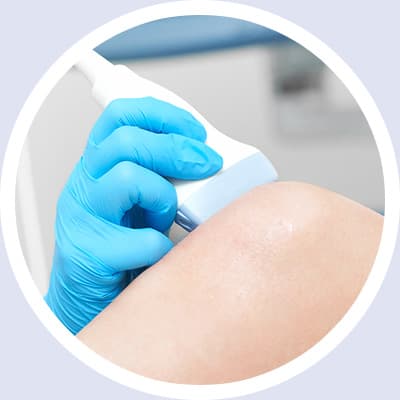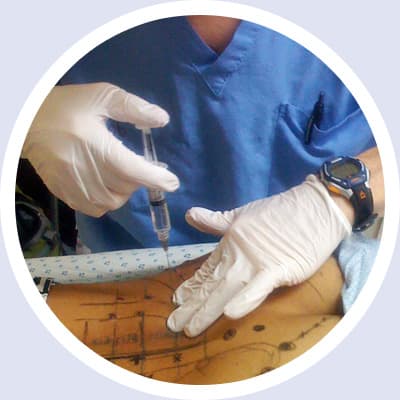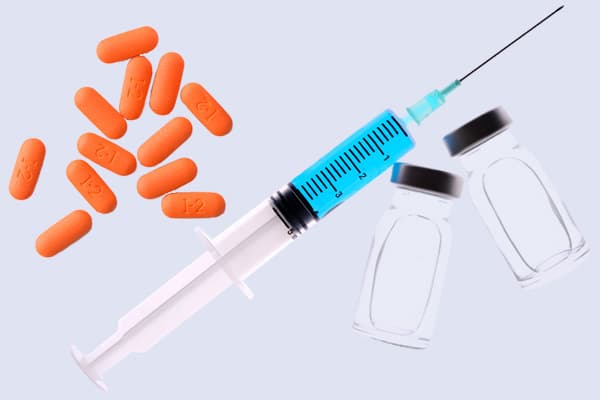Regenerative Treatments
FOR KNEE PAIN
The knee is the main joint that connects the upper and lower leg and endures a great deal of stress in supporting the body’s weight. It connects the thigh bone to the two bones of the lower leg and is supported by ligaments known as the anterior cruciate ligament (ACL), posterior cruciate ligament (PCL), the medial collateral ligament (MCL) and lateral collateral ligament (LCL). There are two menisci in each knee and are made from cartilage and act as cushions. The coronary ligaments attach the meniscus to the tibia.
Knee pain can arise from Osteoarthritis of the knee, meniscal tears, ligament and tendon injuries specifically an ACL sprain or tear, a MCL injury and quadriceps tendonitis. Athletes in particular can be subject to knee injuries and in particular Jumper’s Knee, Patellofemoral Syndrome and Quadriceps and Patellar Tendonitis. Fortunately, knee injuries are particularly responsive to regenerative medicine therapies. Dr. Krasnick can even provide inner knee pain treatments with his regenerative solutions.
Conditions contributing to knee pain include:
The knee is the main joint that connects the upper and lower leg and endures a great deal of stress in supporting the body’s weight. It connects the thigh bone to the two bones of the lower leg and is supported by ligaments known as the anterior cruciate ligament (ACL), posterior cruciate ligament (PCL), the medial collateral ligament (MCL) and lateral collateral ligament (LCL). There are two menisci in each knee and are made from cartilage and act as cushions. The coronary ligaments attach the meniscus to the tibia.
Knee pain can arise from Osteoarthritis of the knee, meniscal tears, ligament and tendon injuries specifically an ACL sprain or tear, a MCL injury and quadriceps tendonitis. Athletes in particular can be subject to knee injuries and in particular Jumper’s Knee, Patellofemoral Syndrome and Quadriceps and Patellar Tendonitis. Fortunately, knee injuries are particularly responsive to regenerative medicine therapies. Dr. Krasnick can even provide inner knee pain treatments with his regenerative solutions.
Conditions contributing to knee pain include:
Osteoarthritis of the Knee
Osteoarthritis of the knee occurs when the cartilage of the knee is damaged or becomes worn, oftentimes simply from normal wear and tear as we age. It can result in swelling, pain and difficulty moving the knee leading to difficulty walking. Pain and weakness can lead to more weakness and instability of the knee which leads to more pain. Multiple types of regenerative medical therapies have been proven to be effective.
Meniscal Tears
The knee has two menisci which are cushions in the knee made out of cartilage. The menisci can become injured and tear and lead to instability of the knee joint which leads to more pain. Tears can happen from a sports injury or from simple wear and tear and with aging. Symptoms of a torn or injured meniscus include: knee popping, pain with moving or rotating the knee, locking of the knee, stiffness and swelling.
Ligament & Tendon Injuries of the Knee
The knee joint is supported by ligaments which connect bone to bone and tendons that connect bone to muscles. There are 4 important ligaments of the knee that can become injured, sprained or torn which then leads to weakness, knee joint instability and more pain. The 4 ligaments are the anterior cruciate ligament (ACL), posterior cruciate ligament (PCL), medial collateral ligament (MCL) and the lateral collateral ligament (LCL).
Tears can occur when there is stress on the knee from side to side motions or from an awkward fall or sports injury particularly with basketball and football players but also skiers, snowboarders, hockey players, soccer, volleyball, baseball and tennis players.The good news is that ligament and tendon injuries of the knee are particularly responsive to regenerative medical therapies.
Patellofemoral Syndrome
Patellofemoral Syndrome is also known as Runner’s knee. It is characterized by pain and swelling of the knee due to inflammation between the knee cap (Patella) to your femur bone from overuse. Injury to this area of the knee leads to weakness of the tendons, causing instability and more knee pain. For athletes, Patellofemoral Syndrome is a recurring problem due to the weakness of the injured ligaments.
Quadriceps Tendonitis / Patellar Tendonitis
Quadriceps tendonitis is inflammation of the tendon that connects the quadriceps which is the large muscles on the top of the thigh to the Patella (knee cap). Typically, it is an overuse injury caused by too much running, jumping or squat type exercises, but can also occur from trauma, sudden increase in physical activity, poor posture and poor walking habits. Pain usually occurs in front of the knee just above the knee cap and can get worse after sitting down for too long or jumping, squatting or running. Persistent injury can lead to stiffness, swelling, weakness and poor mobility which feeds pack into the pain cycle. With patellar tendonitis pain is typically just below the knee cap and significantly aggravated by jumping, squatting, or climbing stairs. Athletes are particularly prone to this problem including basketball players and volleyball players from frequent jumping on hard surfaces. Quadriceps and patellar tendonitis can be a recurring problem due to the weakness of the injured tendons.
THE KRASNICK SOLUTION
How can Dr. Krasnick help you recover and restore naturally to health without drugs or surgery?

EXAM & DIAGNOSIS
Before a patient can be treated for knee pain, a correct diagnosis must be made.
Learn More
First, Dr. Krasnick will obtain a detailed history and perform a thorough physical examination. Frequently a musculoskeletal ultrasound will be done to understand where your knee pain is coming from. If you have any imaging studies such as X-rays, MRI or CT Scans, please bring the actual images to the appointment for Dr. Krasnick to review himself.

TREATMENT PROGRAM
Once a diagnosis is made, a comprehensive treatment program will be determined.
Learn More
This may include regenerative medical treatments such as: Prolotherapy, Platelet Rich Plasma (PRP), Stem Cell Therapy, Prolozone™, Neural Prolotherapy (Lyftogt Technique®) and Hydrodissection. None of these treatments contain any drugs, steroids, narcotics or NSAIDs, are performed in the office and do not require surgery. Dr. Krasnick performs injections under ultrasound guidance, so he is highly accurate in injecting the treatment to the exact location needed. These treatments allow the body’s own natural healing powers to recover and restore to health.

HEALTH & WELLNESS
To optimize treatment, we focus on the whole patient and not just the knee pain.
Learn More
This means Dr. Krasnick will investigate, discuss and make recommendations about your health and wellness. Important factors in order to optimize outcomes include cellular health. This entails optimizing your nutrition and diet to ensure you are getting the proper macro and micronutrients. Simple changes in diet and addition of vitamins and supplements can go a long way to improving outcomes. Dr. Krasnick will also focus on functional movement, which includes strength and flexibility. We know the body, especially, the musculoskeletal system acts as a whole and therefore pre- and post-treatment exercise or physical therapy will be recommended. Of course treatment and attention to the injured structure (joint or surrounding ligaments and tendons) will be discussed in detail, with specific post-procedure protocols when needed.
A procedure is not always needed and when possible trying to solve the problem with other noninvasive and holistic approaches will be sought.
None of the regenerative treatments contain any drugs, steroids, narcotics or NSAIDs, are performed in the office and do not require surgery. Dr. Krasnick performs injections under ultrasound guidance, so he is highly accurate in injecting the treatment to the exact location needed. These treatments allow the body’s own natural healing powers to recover and restore to health.
If you are looking for a non-surgical, drug-free, natural, alternative pain treatment for your knee pain, then contact us at (734) 585-5653 to schedule a consultation with Dr. Krasnick.
OVERVIEW OF KNEE PAIN CONDITIONS
Osteoarthritis of the Knee
More About This Condition
Osteoarthritis of the knee occurs when the cartilage of the knee is damaged or becomes worn, oftentimes simply from normal wear and tear as we age. It can result in swelling, pain and difficulty moving the knee leading to difficulty walking. Pain and weakness can lead to more weakness and instability of the knee which leads to more pain. Multiple types of regenerative medical therapies have been proven to be effective.
Meniscal Tears
More About This Condition
Ligament & Tendon Injuries of the Knee
More About This Condition
The knee joint is supported by ligaments which connect bone to bone and tendons that connect bone to muscles. There are 4 important ligaments of the knee that can become injured, sprained or torn which then leads to weakness, knee joint instability and more pain. The 4 ligaments are the anterior cruciate ligament (ACL), posterior cruciate ligament (PCL), medial collateral ligament (MCL) and the lateral collateral ligament (LCL).
Tears can occur when there is stress on the knee from side to side motions or from an awkward fall or sports injury particularly with basketball and football players but also skiers, snowboarders, hockey players, soccer, volleyball, baseball and tennis players.The good news is that ligament and tendon injuries of the knee are particularly responsive to regenerative medical therapies.
Patellofemoral Syndrome
More About This Condition
Quadriceps Tendonitis / Patellar Tendonitis
More About This Condition
Traditional treatments. Have you tried them and still have pain?

